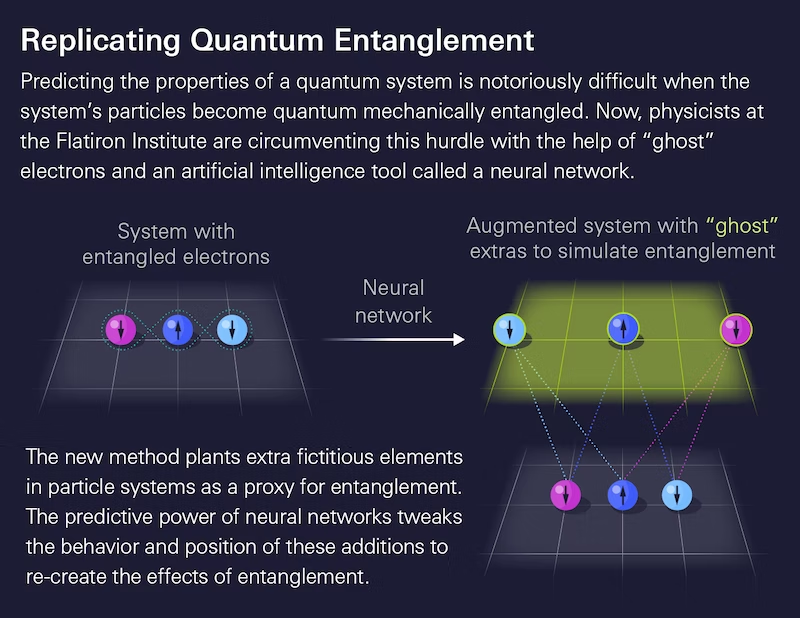Reviewed by Alex SmithAug 4 2022
A new method for simulating quantum entanglement between interacting particles has been developed by physicists from the Center for Computational Quantum Physics at the Flatiron Institute and its partners. Their strategy entails the addition of extra, fake particles that are managed by a neural network, a type of artificial intelligence.

Image Credit: Lucy Reading-Ikkanda/Simons Foundation
To comprehend the mysteries of quantum systems, physicists are (temporarily) augmenting reality.
Calculating the collective behavior of a molecule’s electrons is necessary to predict a material’s characteristics. Such estimates could one day assist scientists in generating new drugs or creating materials with desirable qualities like superconductivity.
The issue is that electrons can stop functioning as separate entities when they get “quantum mechanically” entangled with one another. For any system with more than a handful of particles, the entangled network of connections becomes ridiculously difficult to unravel directly by even the most powerful computers.
Now, quantum physicists from the École Polytechnique Fédérale de Lausanne (EPFL) in Switzerland and the Flatiron Institute’s Center for Computational Quantum Physics (CCQ) in New York City have found a solution.
By including additional “ghost” electrons in their calculations that interact with the system’s genuine electrons, they were able to replicate entanglement.
In the new technique, a neural network artificial intelligence method governs the activity of the extra electrons. The effects of entanglement are recreated without the associated computing challenges by adjusting the network until it finds the exact results that can be projected back into the real world.
The physicists published a report of their technique in the Proceedings of the National Academy of Sciences on August 3rd, 2022.
You can treat the electrons as if they don’t talk to each other, as if they are noninteracting. The extra particles we are adding are mediating the interactions between the actual ones that live in the actual physical system we are trying to describe.
Javier Robledo Moreno, Study Lead Author and Graduate Student, Center for Computational Quantum Physics and New York University
In their latest publication, the physicists show that in simple quantum systems, their strategy is on par with or superior to that of other approaches.
We applied this to simple things as a test bed, but now we are taking this to the next step and trying this on molecules and other, more realistic problems. This is a big deal because if you have a good way of getting the wave functions of complex molecules, you can do all sorts of things, like designing drugs and materials with specific properties.
Antoine Georges, Study Co-Author and Director, Center for Computational Quantum Physics
The long-term objective, according to Georges, is to make it possible for researchers to computationally forecast a material’s or molecule’s qualities without having to create and test it in a laboratory. For instance, with only a few clicks of a mouse, they could test a variety of different compounds for a particular pharmaceutical attribute.
Georges added, “Simulating big molecules is a big deal.”
The study was co-authored by Robledo Moreno, Georges, CCQ research fellow James Stokes, and assistant professor of physics Giuseppe Carleo from EPFL.
The latest research is a development of a 2017 study in Science by Carleo and Matthias Troyer, a technical fellow at Microsoft at present. In that study, fictitious particles were also coupled with neural networks, although they were not classed as fully-blown electrons. Instead, they just had one property known as spin.
Carleo stated, “When I was [at the CCQ] in New York, I was obsessed with the idea of finding a version of neural network that would describe the way electrons behave, and I really wanted to find a generalization of the approach we introduced back in 2017. With this new work, we have eventually found an elegant way of having hidden particles that are not spins but electrons.”
Journal Reference:
Moreno, J. R., et al. (2022) Fermionic wave functions from neural-network constrained hidden states. Proceedings of the National Academy of Sciences. doi:10.1073/pnas.2122059119.